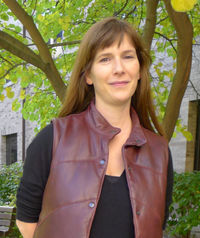The Daily Ant hosts a weekly series, Philosophy Phridays, in which real philosophers share their thoughts at the intersection of ants and philosophy. This is the nineteenth contribution in the series, submitted by Dr. Lorraine Keller.
Ants Doing Math and Kids Doing Linguistics?
It is probably no surprise that the desert ant, Cataglyphis, has already been mentioned several times on this blog (see here, here, and here). As previously discussed, these ants have an extraordinary ability to find their way home in conditions that apparently require triangulation. Cataglyphis has been described as “mentally representing” time, distance, and their location in 3D space (Goldman 2012). More surprisingly, these ants are described as performing simple mathematical calculations that are approximations of the kinds of vector summations that human navigators would use (see Müller and Wehner 1988).

Human navigators use fairly sophisticated mathematical models to describe the ant’s ability to navigate—what we might call the ant’s ‘navigational competence’. But what exactly does possession of this competence entail? Is it plausible that ants possess some sort of mathematical knowledge—if not to the level of sophistication of their human investigators, then at least an approximation of this? Do they, in some sense, mentally represent the various environmental facts that they apparently need to continuously update in order to find their way home?
These questions about Cataglyphis remind me of a similar family of questions that have exercised philosophers and linguists in a debate that goes back (at least in some form) to Plato. The questions cluster around the phenomenon of linguistic competence. There’s debate about what linguistic competence includes, but for our purposes, we can understand competence with a language L to entail the ability to distinguish the grammatical from the ungrammatical L-sentences—as we might naturally put it, “knowledge” of the grammar of L. To use a famous, if hackneyed, example, young English-speaking children know that even though
1. John is easy to please.
and
2. John is eager to please.
have superficially similar structures,
3. It is easy to please John.
is an acceptable transformation of 1, but
4.* It is eager to please John.
is not an acceptable transformation of 2. How do they know this? And what precisely is it that they know?
Chomsky’s famous poverty of the stimulus argument starts with the claim that young children’s linguistic competence cannot be explained by their exposure to the primary linguistic data (see, inter alia, Chomsky 1965). Very roughly, the linguistic data to which children are exposed (viz., the speech of members of their linguistic community) are too impoverished to account for children’s discriminatory grammatical abilities (among other things). If children were “empiricist learners”—i.e. if they didn’t have any “innate language-specific knowledge or biases”—they wouldn’t be competent with their languages (Laurence and Margolis 2001: 221). But they are. Linguists and philosophers have wondered: what explains this competence? However, an even more foundational question needs to be answered: in what does such competence consist? What do children “know” when they know the grammars of their languages, if it even makes sense to describe what underlies their ability as knowledge?

Chomsky’s controversial answer was that children have innate knowledge of the abstract, general grammatical rules that underlie all human languages (Universal Grammar). Exposure to the primary linguistic data then enables them to learn the particular grammars of their native languages. In the face of strong criticism from philosophers, Chomsky backed off from his initial use of ‘knowledge’ to describe children’s linguistic competence and started using the technical term ‘cognize’ (Chomsky 1980, see Cowie 2008 for discussion). But what exactly is it to cognize grammar? Linguists following Chomsky seem to agree that cognizing one’s grammar entails mentally representing one’s grammar, whatever else it might involve.
What exactly is it that children mentally represent? To return to the above example, their ability to correctly judge that 3 is grammatical while 4 is not is based on the fact that they mentally represent the syntactic structures of 1-4—or so the explanation goes. Hence, they realize (at some level) that although 1 and 2 look like they have the same structure, their syntactic structures are really something like this (the structures of these sentences at LF according to Minimalist Syntax are much more complicated than below):
1S: [Johni [is easy [x [to please ( )i]]]]
2S: [Johni [is eager [( )i [to please x]]]]
The basic idea is that children mentally represent these structures as part of their understanding of sentences 1 and 2, which is why they are able to correctly interpret them as saying, in essence, ‘John is such that he is easy for someone to please’ and ‘John is eager that he please someone’.
Clearly, children aren’t consciously aware of any such structures as 1S or 2S (or their more accurate, vastly more complicated, counterparts). Most adults aren’t even aware of them. Even worse, many competent speakers (most, if not all, non-linguists!) would not even know how to decipher them. (These are some of the reasons that led Chomsky to back away from the term ‘knowledge’.)
As with our description of the ants’ navigational competence, we use highly complicated, mathematical representations to describe children’s linguistic competence. If it is implausible that children have knowledge of the information encoded by these representations, it is at least equally implausible that ants have knowledge of the information encoded by trigonometric representations. But both children and ants have some sort of cognitive connection—call it ‘cognizing’ or whatever—to the information encoded by these representations. After all, their behavior is, in some sense, guided by this information. We can, if we like, say that they mentally represent this information, but it is still far from clear what this means.
So, are ants doing trigonometry? Are kids doing minimalist syntax? Obviously not in the sense that mathematicians and linguists are doing these things. But their behavior is guided, in some not very well-understood way, by the information that is part of the content of mathematicians’ and linguists’ theories.
REFERENCES
Chomsky, Noam. 1965. Aspects of the Theory of Syntax. Cambridge, MA: MIT Press.
—. 1980. Rules and Representations. New York: Columbia University Press.
Cowie, Fiona. 2008. Innateness and Language. The Stanford Encyclopedia of Philosophy (Winter 2016 Edition), Edward N. Zalta (ed.), URL =
<https://plato.stanford.edu/archives/win2016/entries/innateness-language/>.
Goldman, Jason G. 2012. Desert Ants Are Better Than Most High School Students At Trigonometry [Blog post]. https://blogs.scientificamerican.com/thoughtful-animal/desert-ants-are-better-at-trigonometry-than-most-high-school-students/
Laurence, Stephen and Margolis, Eric. 2001. The Poverty of the Stimulus Argument. British Journal of Philosophy of Science 52 (2001): 217-276.
Müller, Martin and Wehner, Rudiger. 1988. Path Integration in Desert Ants, Cataglyphis Fortis. Proceedings of the National Academy of Sciences of the United States of America, 85 (14), 5287-5290.
 Dr. Lorraine Juliano Keller usually teaches philosophy at Niagara University and works at the intersection of philosophy of language and metaphysics, but spent the past year researching divine ineffability at the University of Notre Dame’s Center for Philosophy of Religion. She was first introduced to Cataglyphis by her advisor, Marian David, who has a fondness for ants.
Dr. Lorraine Juliano Keller usually teaches philosophy at Niagara University and works at the intersection of philosophy of language and metaphysics, but spent the past year researching divine ineffability at the University of Notre Dame’s Center for Philosophy of Religion. She was first introduced to Cataglyphis by her advisor, Marian David, who has a fondness for ants.